To guarantee that you never receive complaints it is essential to invest in a quality wine cooler that protects wine and achieves optimum storage conditions.
Wine coolers
Wine Refrigeration Vs Standard Refrigeration
- Designed to gradually lower temperatures and maintain optimum humidity levels conducive to the storage of wine.
- Maintains consistent temperature.
- Solely for wine storage eliminating the risk of other odors permeating into the taste.
- Typically feature absorption systems to reduce and suppress vibration and noise.
Standard refrigeration
- Designed to rapidly drop temperatures and expel humidity.
- Generally work at temperatures around 4°C, far too cold for ideal wine storage.
- Reduced humidity can risk drying out corks and damaging wine.
- Compressors can cause vibration which interrupts the maturing process.
Specialised wine coolers should be at the top of the shopping list for all businesses that take their wine seriously. Understanding what to look for can guarantee that you make a wise investment and always receive exactly what you need.
Areas to consider
- Size. The space you have available will dictate the type of wine chiller cabinet you can house. With upright and under counter units available there will be a product for every premises.
- Capacity. The number of wine bottles you need to store will dictate the capacity you require. Smaller businesses will obviously have fewer storage demands while larger bars will need considerably more. With a full range of capacities able to hold from 11 x 750ml bottles through to 191 x 750ml bottles there are products able to cope with all demands. Always remember that Champagne and Burgundy bottles will generally be bigger and take up more room.
- Insulation. Adequate insulation will not only ensure that temperatures remain consistent and performance is enhanced but also that warmer ambient air does not affect the storage conditions. Insulation will aid efficiency and should help to keep running costs as low as possible.
- The number of doors. The number of doors will relate to the size of the equipment. With single and double options available you can choose whichever wine chiller is more suitable for your business needs and individual layout.
- Dual temperature. A dual temperature cooler provides premium storage for both white and red wines achieving perfect serving temperatures for each within one unit. Rather than purchase two separate pieces of equipment, one for red and one for white, it is sometimes more beneficial to combine both and save space. Each of the two sections can be set to different temperatures creating a combined display that doesn’t compromise the integrity of the wine regardless of colour.
- Temperature range. The temperatures you require will depend on the wine that will be stored. White wines should be served between 7°C-11°C depending on variety while red wines should be served between 14.5°C-18°C. As a general rule, the lighter the wine the colder the serving temperature. Look for an easy to use control panel and a precise thermostat to allow easy monitoring and full control over conditions.
- The number of shelves. The larger the unit the more shelves there will be. Shelving will generally be adjustable to provide full flexibility when personalizing and organizing your storage facilities. All shelves should be manufactured from strong and durable materials to offer additional safety for valuable bottles.
- Price. While this is a major factor you should try not to make it the primary consideration. There is a wide range of prices suitable for all budgets however if you want to keep wines in premium condition and are serious about quality, with wine being the main attraction for your business, it is wise to purchase flagship products without scrimping on cost.
Additional areas
- It is recommended to purchase equipment that features UV filters on the glass. Strong sunlight on wine bottles can damage the product and reduce quality.
- A clear temperature display will ensure easy reference, allowing users to closely monitor conditions to guarantee optimum storage conditions.
- Many wine cabinets are designed with internal illumination, showcasing bottles in the most attractive way.
- Decide whether your wine cooler would benefit from a secure lock. This feature can provide safety for valuable bottles and act as a deterrent against potential theft.
- With a choice of exterior colours available you can style the overall unit according to your existing design and décor. With chrome, brown, black, grey and stainless steel to choose from, there is a unit to complement all businesses.
- The shelf finish can be selected to fit with external materials providing a complete uniformed appearance that is aesthetically pleasing. If you prefer a contrasting effect this can also be arranged with a choice of cream, wood, white, chrome and stainless steel.
- You may have a preferred manufacturer and wish to stick to what you already know. If this is the first wine chiller you have purchased always be sure to discover what each brand can offer. You may find that paying slightly more initially will save you money in the long run.
- Warranties will vary from manufacturer to manufacturer. While some will offer full parts and labor warranty other products will be supplied with parts only cover. The period that the warranty covers will also vary. Generally, a full warranty for the longest period is best providing the support and service you need in case of future problems.
Before choosing your perfect wine chiller it is vital to understand how wine should be stored and the basic principles of wine refrigeration as opposed to alternative standard forms of refrigeration.
This buying guide aims to highlight important aspects that should be considered before making a purchase and provide information on why a commercial wine bottle cooler is the only way to store your prized wine collections.
The wine in your fridge is starting to take up a bit more space than you’d like, causing you to choose whether you store your red wine or a carton of milk, and you’ve realized it’s time to give the wine its own home – that’s right, you’re in the market for a wine fridge. Whether you’re buying the wine fridge because you’d like to keep a few bottles longer than the twenty-four hours you usually do post-purchase, you’ve run out of space in your fridge or on your counter, or because you just think it makes you look sophisticated, buying one can be a daunting task, so here are some quick tips as we enter the prime purchasing season.
First, we want to be clear, our tips are for people searching for an affordable option to store under 50 or so bottles. We’re talking the low to mid hundreds in price. If you are looking for an expensive wine cabinet to cellar your collection, there are plenty of places out there to find the best products, but this advice probably isn’t for you.
Smaller wine fridges mainly break down into two types: fridges that have a compressor like a normal refrigerator and “silent” fridges that are thermoelectric.
The fridges that use a thermoelectric system are often touted as better because they’re very quiet. If silence is golden to you, then by all means, look in to buying one of these units, but thermoelectric units don’t really bring cool air into the unit as much as they pull heat out of the unit. Once the heat has been pulled out, the fridge just helps keep the cooler air that has been separated from the hotter air inside. If you’re starting to feel like this means thermoelectric units don’t really cool the bottles all that much, you’d be right. But hey, they’re quiet, and that’s one of the main reasons they’re so popular.
Compressor units, on the other hand, function just like a mini fridge would. When the thermostat inside senses the temperature has risen above the set degree, the compressor kicks on and cools the entire unit back down. While the hum of the compressor may be a bit noisier than the thermoelectric units, they work much better at actually keeping the bottles cool, which is why we prefer them.
After deciding on the type of wine fridge to buy, it’s time to decide if you purchase a fridge with single or dual zone temperature controls. What having a fridge with dual zones means is that in theory, you’ll be able to have two different temperature levels inside your fridge, thereby keeping your whites and reds at their separate temperatures. But if you’re in the market for a fridge that holds under 50 bottles, this idea of two truly separate zones doesn’t really exist in reality. That’s because the fridge is so small, it’s pretty hard to ensure the top stays cold and the bottom a bit warmer, or vice versa. We actually spot tested a few of these dual zone fridges, and the temperature was pretty consistent throughout.
So don’t waste your money on the idea that for this size you’ll be able to keep your wines at different temperatures; simply buy a single zone fridge and set it to sixty degrees. Good for both your reds and your whites.
Finally, the size and style of the fridge are really up to you. Whether you prefer wood or metal racks, and either a black or stainless steel exterior, allow what you purchase to be dictated by your style. Also, keep in mind that a fridge’s bottle capacity is usually based on the standard Bordeaux-style bottle, so if you aren’t able to fit exactly 50 bottles inside the unit, it’s probably just because your bottle sizes are all different, which prevents them from perfectly fitting together. Don’t assume you were lied to by the manufacturer.


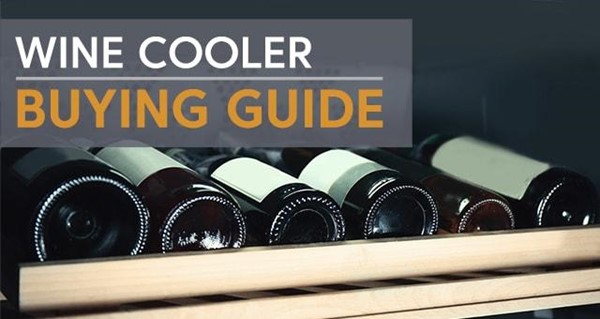
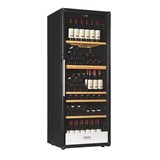








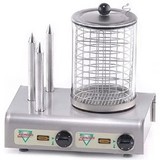


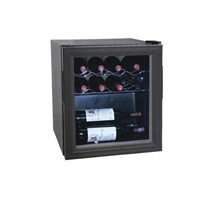




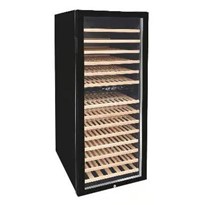


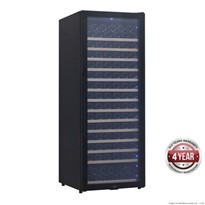

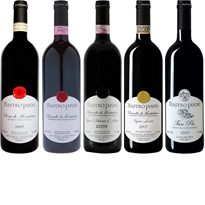
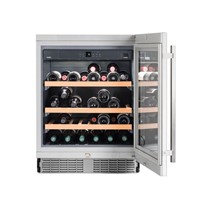
-205x205.jpg)